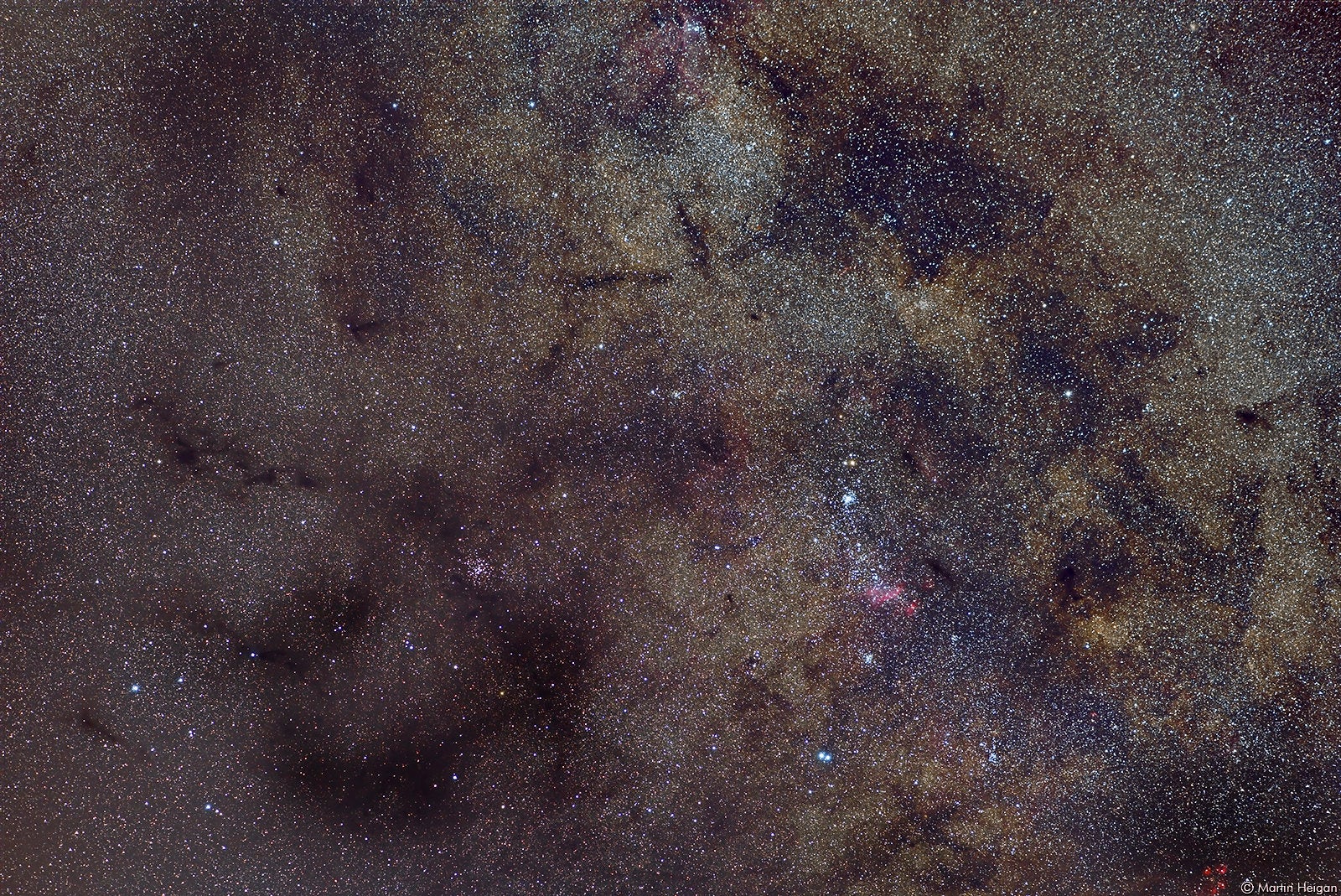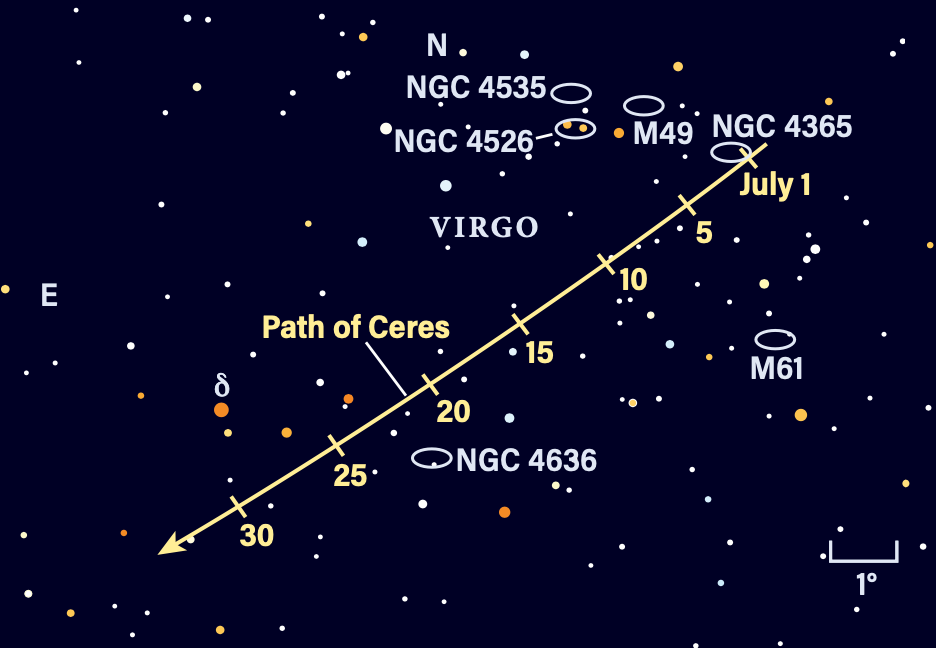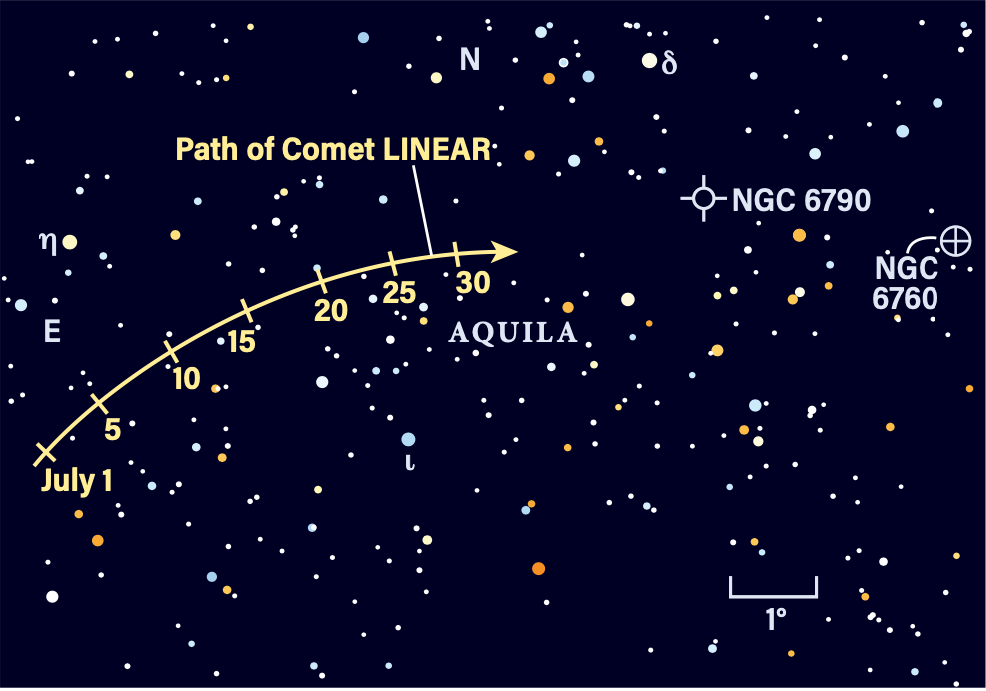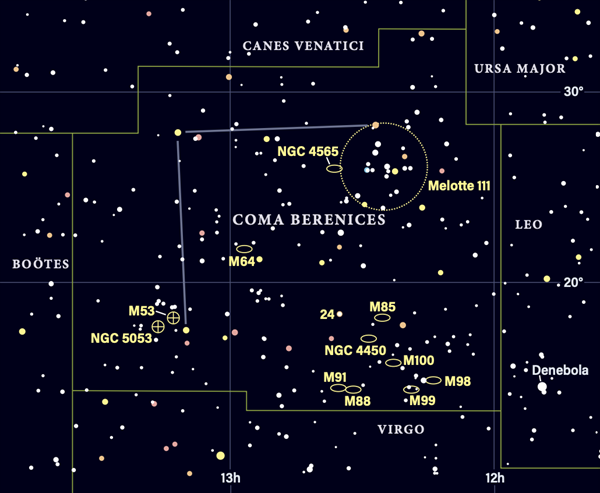
Friday, July 21
The distant dwarf planet Pluto reaches opposition at midnight EDT. Located in Sagittarius, it’s best seen in the late-night or early-morning hours for those in the Northern Hemisphere. The tiny world is dim — 14th magnitude — and requires a large scope to pick up.
Fortunately, there’s a bright landmark nearby. The globular cluster M75 can serve as either a great jumping-off point in your search for Pluto, or as your final destination for those with smaller scopes or binoculars. You’ll find M75 about 8° south-southwest of magnitude 3.1 Beta (β) Capricorni. M75 glows at magnitude 8.5 and spans just less then 7′ on the sky. It’s so faint because it’s so far away, sitting some 67,500 light-years from Earth. Its shape is compact, meaning that its center is harder to resolve into stars, while its outskirts are a bit sparse. Smaller scopes and lower magnification will simply show M75 as a fuzzy, gray-white ball.
If you have a large scope and are ready to progress to Pluto, it’s quite simple: Slide 1.1° due south of M75’s center to land on the icy world. The dwarf planet appears less than an arcsecond across, with a slightly grayish, “flat” appearance compared to the field stars around it.
Sunrise: 5:49 A.M.
Sunset: 8:24 P.M.
Moonrise: 9:20 A.M.
Moonset: 10:46 P.M.
Moon Phase: Waxing crescent (14%)
*Times for sunrise, sunset, moonrise, and moonset are given in local time from 40° N 90° W. The Moon’s illumination is given at 12 P.M. local time from the same location.

Saturday, July 22
Dwarf planet 1 Ceres is nearing the central regions of the sprawling constellation Virgo. The main belt’s biggest body is a modest magnitude 8.8; binoculars or a small scope should show it. Ceres now sits roughly 2.5° west of 3rd-magnitude Delta (δ) Virginis and is passing near the 10th-magnitude galaxy NGC 4636. Ceres is brighter than most of the field stars around it, helping to aid in its identification. Although you won’t see it move during a single observing session, you can sketch or photograph the field tonight and come back every few nights to repeat the process — the dot that has moved is Ceres.
Its temporary extragalactic neighbor, NGC 4636, is an elliptical galaxy in a group on the outskirts of the larger Virgo Supercluster of galaxies, whose center sits to the north-northwest. You’ll find NGC 4636 just 1° south-southwest of Ceres’ position and just over 3° southwest of Delta. Through any telescope, it appears as a 6′-long fuzzy oval with a brighter center.
For those who want a brighter target, magnitude 2.7 Porrima lies just 4° south of NGC 4636 and 6° southwest of Delta. Porrima, also cataloged as Gamma (γ) Virginis, is a stunning double star. Both components are roughly the same type and brightness, making the pair look like an identical set of headlights piercing the darkness of space. They’re currently separated by 3″ but can lie as far as 6″ from each other when their elliptical orbit carries them farthest apart.
Sunrise: 5:50 A.M.
Sunset: 8:23 P.M.
Moonrise: 10:19 A.M.
Moonset: 11:07 P.M.
Moon Phase: Waxing crescent (21%)

Sunday, July 23
Flying high in the east two hours after sunset is mighty Aquila the Eagle. The constellation’s brightest star, magnitude 0.8 Altair, anchors one of the three points of the Summer Triangle asterism. From Altair, scan 8.3° southwest to land on 3rd-magnitude Delta Aquilae. Once you’ve located this bright star, take a jump of about 4° southeast this time to land on Comet 237P/LINEAR.
Currently around 13th magnitude, LINEAR will take a modest to large scope and dark skies to spot its fuzzy outline against the background stars. If you need a brighter target, though, there’s one nearby: 9th-magnitude globular cluster NGC 6760. This ancient ball of stars lies just over 4° southwest of Delta. This is a great stop if your instrument or the conditions eliminate your chances of catching LINEAR. If you can capture both, take some time with each, especially at higher magnification (150x or more). Consider how each appears and contrast it with the other.
Sunrise: 5:50 A.M.
Sunset: 8:22 P.M.
Moonrise: 11:19 A.M.
Moonset: 11:27 P.M.
Moon Phase: Waxing crescent (29%)

Monday, July 24
Now is the perfect time to enjoy the long, sinuous shape of Scorpius the Scorpion in the southern sky. Depending on your latitude, you may be able to catch the entire constellation, though observers in more northern regions might start to lose the curve of Scorpius’ tail to the horizon.
An hour or two after sunset, the Scorpion stands on that tail just to the lower right of the Teapot asterism in Sagittarius, near the bright center of the Milky Way. This region is littered with glittering stars, dark dust clouds, and deep-sky objects, with a long list of options for eager observers. Beginners can start with magnitude 1.1 Antares, the bright star marking Scorpius’ red heart. Look to the right (west) of this star for the arachnid’s claws, or to the lower left (southeast) to follow the line of its body to the end of its stinging tail.
Above the end of the tail are M6 and M7, two famous open clusters of young stars. Both are visible to the naked eye under dark skies: M6 is magnitude 4.2 and M7 is magnitude 3.3. To study them closer, all you’ll need is binoculars or any small scope.
Let’s start with M6, the Butterfly Cluster, which lies 5° north-northeast of Shaula, Scorpius’ 2nd-magnitude lambda star. Spread across about 25′, this stunning group resembles a butterfly with its wings outstretched. Some 3.8° to M6’s southeast is M7, also called Ptolemy’s Cluster. This brighter, larger cluster covers about 80′ and, as its name implies, has been known since ancient times, owing its first recorded mention to Ptolemy around A.D. 130. Behind its brightly glittering stars is a scattered background of fainter, more distant suns in the disk of the Milky Way.
Sunrise: 5:51 A.M.
Sunset: 8:21 P.M.
Moonrise: 12:20 P.M.
Moonset: 11:48 P.M.
Moon Phase: Waxing crescent (38%)
Tuesday, July 25
First Quarter Moon occurs at 6:07 P.M. EDT. At that time, Luna is high in the south, allowing for something a little unusual: daytime observing. You can enjoy the half-lit Moon with binoculars or a telescope, but take extreme care never to point your optics in the direction of the Sun, even for a brief period of time. Roughly aim your telescope at the Moon without looking through the eyepiece or the finder scope to ensure your gaze is nowhere near the Sun before putting your eye to it. Do the same with your binoculars, finding the general location of the Moon first before looking through the eyepieces.
At this phase, the terminator dividing lunar night and day strikes right down the middle of the visible face of our satellite, which floats in the constellation Virgo. Most readily visible are features on the eastern portion of the disk, including the seas of Serenity, Tranquillity, and Fertility. The bright crater Stevinus may also stand out in the lunar southeast.
As darkness finally falls, the stars will slowly begin to appear around our satellite. Nearby to the west is the bright star Spica, Virgo’s magnitude 1 luminary. The diamond shape of Boötes, with its bright star Arcturus, hangs northeast of the Moon.
Sunrise: 5:52 A.M.
Sunset: 8:20 P.M.
Moonrise: 1:23 P.M.
Moonset: —
Moon Phase: Waxing crescent (48%)
Wednesday, July 26
Mercury passes 5° north of Venus at 9 A.M. EDT. Check out the scene around sunset this evening, when the pair hangs together — along with Mars — in southwestern Leo the Lion, low in the western sky.
The scene has changed quite a bit from earlier in the month. Venus hangs close to the horizon, just 3° high 30 minutes after sunset. Fortunately, its bright magnitude — now –4.6 — should help you spot it, even so low in the sky. If you can catch it with a telescope, you’ll see the planet is now just 9 percent lit and stretches a full 50″ wide. Still 5° to its north is Mercury, shining at magnitude –0.1 and nearly 7° above the horizon. The solar system’s smallest planet now appears almost 70 percent lit and is just 6″ across, tiny compared to Venus. To the pair’s upper left is ruddy Mars, much fainter at magnitude 1.8. The Red Planet is still some 13° above the horizon, setting around 10 P.M. local daylight time. It’s even smaller in appearance than Mercury — a mere 6″ across, thanks to its distance.
As the sky darkens, you might notice a bright star appear between Mercury and Mars, in line with the two planets. This is Regulus, the brightest star in Leo.
Sunrise: 5:53 A.M.
Sunset: 8:20 P.M.
Moonrise: 2:29 P.M.
Moonset: 12:11 A.M.
Moon Phase: Waxing gibbous (58%)
Thursday, July 27
Let’s skip into the morning sky to catch the moon Io and its shadow transiting the face of Jupiter, king of planets. The gas giant is climbing in the east for most of the U.S. just before 3 A.M. EST this morning, when the dark blot of Io’s shadow appears on the eastern portion of the disk around 2:50 A.M. EDT. It skims westward, covering more than half the disk before Io finally joins it just before 4:14 A.M. EDT, approaching from the east.
Depending on your location, you may or may not catch the two leaving the disk before sunrise. The shadow slips away around 4:55 A.M. EDT, while Io itself takes until 5:23 A.M. CDT (well after sunrise on the East Coast and when the sky is quite light in the Midwest) to finally depart the western limb. Meanwhile, the planet’s other three Galilean moons are visible as well: Europa to the east, and Ganymede (closest) and Callisto to the west.
There’s another feature visible for many this morning that you’ll want to catch. The Great Red Spot is also crossing the disk this morning. It appears on the planet’s central meridian roughly around 3:40 A.M. EDT but can be seen east or west of this position for an hour or two on either side of this time.
Sunrise: 5:54 A.M.
Sunset: 8:19 P.M.
Moonrise: 3:40 P.M.
Moonset: 12:38 A.M.
Moon Phase: Waxing gibbous (68%)

Friday, July 28
Hopping back into the evening sky, Mercury has moved considerably and passes 0.1° south of Regulus at 9 P.M. EDT. Depending on your location, the Sun may still be above the horizon, so wait for sunset to catch the pair.
About 40 minutes after sunset, Mercury and Regulus are 5° high in the west. Home in with binoculars or a telescope to spot them in the same field of view. Venus is already gone by this time, below the horizon as it continues to close in on the Sun. Mars is now some 11.3° east of Mercury, moving eastward as well night by night, just not as quickly.
Once darkness fully falls, look northeast of Leo to enjoy the small, starry constellation Coma Berenices. Rich with deep-sky targets, the brightening Moon may wash out some of its fainter treasures, but there’s still plenty to enjoy. The double star 24 Comae Berenices, open cluster Melotte 111, and bright lenticular galaxy M85 are your best bets. See the star chart above for their locations relative to the bright star Denebola, which marks the tip of Leo’s tail.
Sunrise: 5:55 A.M.
Sunset: 8:18 P.M.
Moonrise: 4:52 P.M.
Moonset: 1:13 A.M.
Moon Phase: Waxing gibbous (78%)

Sky This Week is brought to you in part by Celestron.









